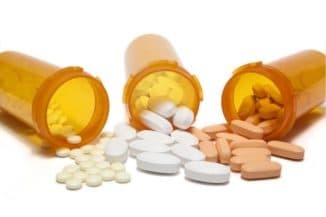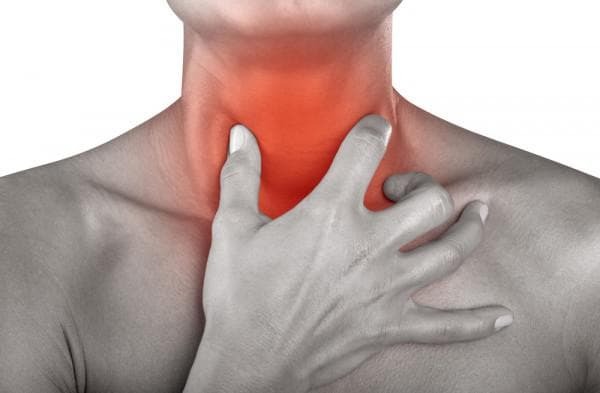
Angina is an inflammatory disease of the tonsils of the pharynx. It can be of different types, have a viral nature, affect people of different ages. Doctors have developed an accurate scheme for the treatment of angina, which involves taking antibacterial drugs( antibiotics), using folk methods and conducting physiotherapy procedures.
What are the best folk remedies for sore throats are most often used, is stated in the article.
Content
- 1 Types and angina symptoms
- 2 Treatment of angina antibiotic
- 2.1 Forms prescribed antibiotics
- 2.2 Indications and contraindications to
- 2.3 Recommended dosage and duration of treatment
- 3 Possible complications of tonsillitis
- 4 Video
Types and symptoms of angina
 main task of doctors -differentiate the virus that caused the development of the inflammatory process of palatine tonsils - it can be streptococcal infection and another. From exact differentiation depends the treatment scheme - streptococcus means the appointment of certain antibiotics.
main task of doctors -differentiate the virus that caused the development of the inflammatory process of palatine tonsils - it can be streptococcal infection and another. From exact differentiation depends the treatment scheme - streptococcus means the appointment of certain antibiotics.
Russian doctors distinguish the following types of sore throat:
- catarrhal;
- follicular;
- lacunar.
It is interesting that apart from Russia this classification does not interest anyone, doctors all over the world only study the nature of the origin of the disease in question.
The main signs and symptoms of any type of angina are:
- sore throat when swallowing both solid and liquid foods;
- temperature increase;
- feeling of presence of a lump / foreign body in the pharynx.

A "lump" in the throat is one of the characteristic first symptoms of angina
A signs of angina of different kinds can be diagnosed only by the doctor when examining the patient:
- catarrhal - the throat has pronounced flushing( reddening), palatine tonsils slightly enlarged;
- follicular - on the tonsils there are white rashes( "asterisks" that are filled with purulent contents;
- lacunar - purulent plaque is dense, located both on the surface of the tonsils and the mucous throat
How does the throat rinse with soda and salt in anginafind out from the article
A specific type of angina can be determined only by a specialist after examination of the patient. If signs of this infectious disease appear, it is necessary to undergo examination and get a competent appointment of treatment, evenif it is intended to conduct therapeutic methods at home
Treatment of sore throat with antibiotics
Antibiotic therapy is an indispensable part of the treatment, along with folk methods of treatment of sore throat. Antibiotics should be prescribed by a doctor - this will guarantee not only obtaining the desired effect, but also safety for health.this, you need to isolate the virus that caused the development of an infectious disease, and pick up an active antibiotic. If necessary, the specialist must change the treatment regimen and the drug itself - this may be dictated by the lack of results after three days of taking antibiotics.
Types of antibiotic
 In case of angina, antibacterial drugs produced in tablets are most often prescribed. Very rarely, when the disease is in severe form and you need to quickly remove the symptoms of infection, the doctor can prescribe intramuscular injections. Sometimes a sore throat is prescribed a local antibiotic - for example, in the form of a spray.
In case of angina, antibacterial drugs produced in tablets are most often prescribed. Very rarely, when the disease is in severe form and you need to quickly remove the symptoms of infection, the doctor can prescribe intramuscular injections. Sometimes a sore throat is prescribed a local antibiotic - for example, in the form of a spray.
The most popular antibiotics, which have a therapeutic effect in the treatment of angina:
- Amoxicillin, Amoxiclav - antibiotics of the penicillin series, which differ in the absence of toxic effect, have a wide spectrum of action.
- Cefazolin, Cefalexin - antibiotics of a new generation, cephalosporin series, characterized by rapid action.
- Sumamed, Chemolycin, Sytrolide is a group of macrolides that are actively used by those patients who have hypersensitivity / individual intolerance to antibiotics of the penicillin series.
What symptoms with angina are the most basic and how to deal with them, you can find out by reading this article.
Antibacterial drugs of the penicillin line will not give a therapeutic effect if the sore throat is in severe form.
In some cases, it is possible to diagnose the infectious disease at an early stage, even in severe cases. In this case, the use of penicillin antibiotics should be under the supervision of doctors - in the absence of positive dynamics, the treatment regimen changes.
What broad-spectrum antibiotics for angina are most often used and are the most effective, is indicated in the article.
Indications and contraindications for prescribing

Only the doctor determines the expediency of prescribing antibiotics!
Antibiotic drugs( antibiotics) are prescribed for diagnosed angina in the following cases:
- is an infectious disease caused by streptococcus;
- the course of the disease is severe - the patient has a critically high body temperature, against which there is a convulsive syndrome;
- the doctor determines the high risk of the transition of the acute form of angina to chronic.
What are the symptoms of angina and treatment in a child, is indicated in this article.
The expediency of prescribing antibacterial drugs should be determined only by a specialist - it is entirely possible that the treatment will be effective without antibiotics. The regimen of admission and the duration of the course of therapy should be selected individually.
Recommended dosages and duration of treatment course
 How many antibiotics should I drink with angina? The minimum course of taking any group is 7 days, the maximum - 10. Even if there is a noticeable improvement in the patient's condition, symptoms of angina have become less pronounced as early as 3-4 days of treatment, it is impossible to interrupt reception of prescribed medications. First, it can cause a sudden relapse of symptoms( they come back with more severity), and secondly, the view that the less the antibiotic is taken, the less damage will be done to the health - wrongly.
How many antibiotics should I drink with angina? The minimum course of taking any group is 7 days, the maximum - 10. Even if there is a noticeable improvement in the patient's condition, symptoms of angina have become less pronounced as early as 3-4 days of treatment, it is impossible to interrupt reception of prescribed medications. First, it can cause a sudden relapse of symptoms( they come back with more severity), and secondly, the view that the less the antibiotic is taken, the less damage will be done to the health - wrongly.
How does the bug angina code for μb 10, can be seen in the content in this article.
Antibiotic doses are selected strictly individually and depend on the severity of the flow of angina, the general well-being of the patient, its susceptibility to antibacterial drugs, the presence / absence of allergy.
Possible complications of sore throat

Complications of sore throat may not develop immediately - on average, the period before the onset of the first signs is 20-25 days.
Angina is an infectious disease that occurs more often without complications. But such dynamics of the disease is possible only with the proper treatment, regardless of whether antibiotics have been prescribed or not. In some cases, the following complications can be diagnosed:
- scarlet fever - occurs due to infection with streptococcal infection, is more often detected in children aged 5 years;
- arthritis of the septic type;
- rheumatic fever;
- is an acute form of glomerulonephritis.
How is treatment of purulent sore throat Lugolem, you can find out by reading this article.
These pathologies became rarely recorded against the background of angina due to antibiotics - these drugs are actively destroying streptococcal infection.
If the angina is treated at home and without the advice / prescription of a doctor, complications may not develop immediately - on average, the period before the onset of the first signs is 20-25 days.
With follicular and lacunar angina, a purulent process can spread to tissues in the immediate vicinity of the palatine tonsils. Extensive abscesses can lead to surgical intervention.
What to do when there was angina during pregnancy in the early stages, how to cure it and what means, is indicated in the description for this article.
Video
Learn more about the use of antibiotics in angina in this video:
Antibiotic treatment is an effective method to quickly get rid of the infection that triggered the development of sore throat. Do not rely on reviews of inexpensive and allegedly effective antibiotics for angina, read on the Internet. The decision to take specific antibacterial agents, their dosage and the duration of treatment should be taken by a doctor - this is a guarantee of the safety of even potent drugs.
